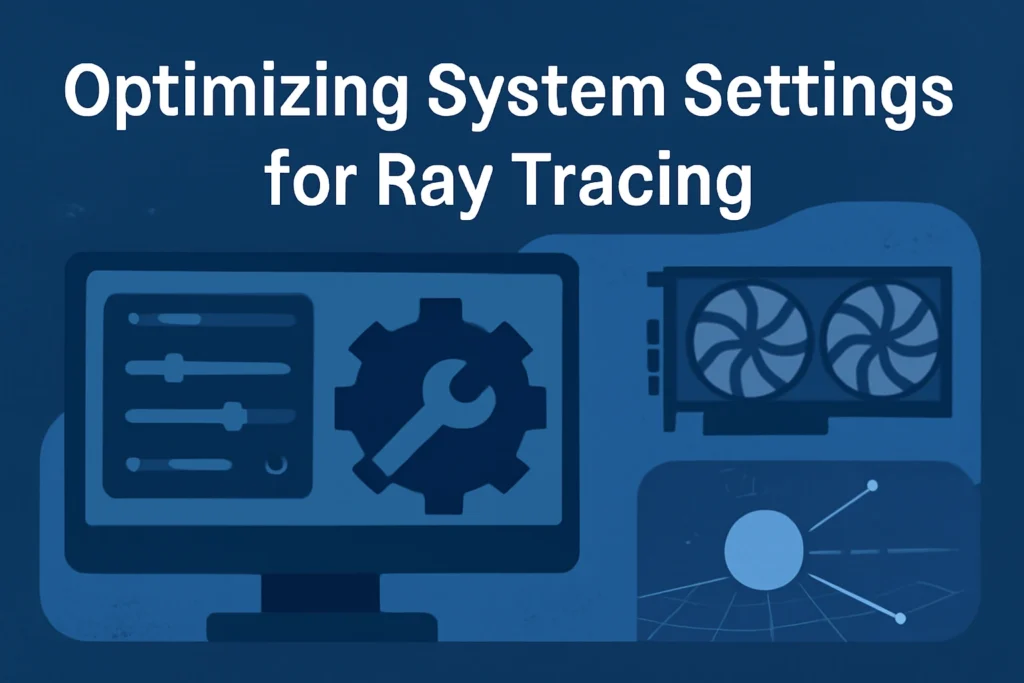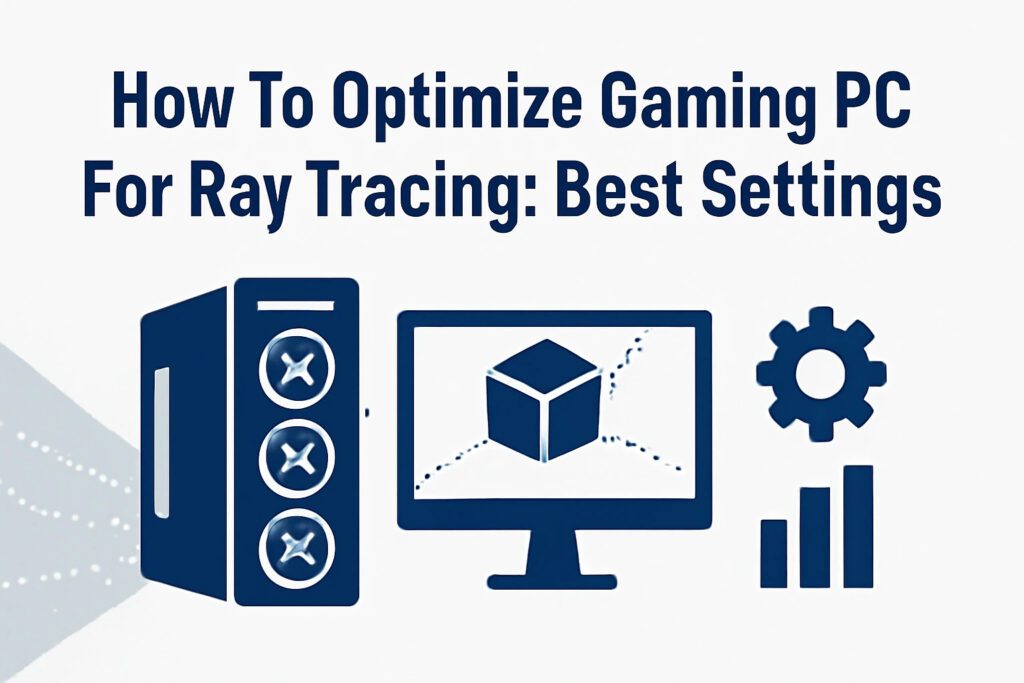Introduction
Ray tracing transforms your gaming PC experience by simulating how light interacts with objects, creating lifelike reflections, shadows, and realistic lighting that make every scene pop. Learning how to optimize your gaming PC for ray tracing ensures smoother frame rates, reduces input lag, and enhances the overall gaming experience, whether you’re exploring expansive open worlds or competing in fast-paced online matches. With the right GPU, CPU, and graphics settings, you can fully enjoy HDR best settings and ray-traced visuals without sacrificing performance. Fine-tuning these elements unlocks a consistent and immersive gameplay experience that modern games demand.
Understanding Ray Tracing in Games
What is Ray Tracing?
Ray tracing simulates real-world lighting to deliver realistic visuals in PC games you use for gaming, creating lifelike shadows, reflections, and dynamic lighting that traditional rasterization can’t achieve. This technique enhances immersion, making environments and characters appear more natural while improving the overall gaming experience.
Benefits of Ray Tracing
Enabling ray tracing on your gaming PC unlocks HDR best settings, realistic reflections, and smoother graphics, delivering a consistent and immersive online gaming experience. Frame rates can be maintained with GPU optimization, while DLSS helps ensure your PC improves performance without sacrificing visuals, especially when you reboot your PC.
Features to Look for in Games
Look for path tracing, ray-traced reflections, and support for modern GPUs and DLSS. Newer games utilize advanced ray tracing features more efficiently than older titles. For more tips on graphics enhancements and performance settings, check Tech Radars homepage.
Essential Hardware Requirements
GPU Recommendations
To optimize your gaming PC for ray tracing, a powerful GPU is crucial for utilizing features like ray tracing effectively and ensuring your entire PC runs smoothly. NVIDIA RTX series like 2060, 3080, and 4090, or AMD RDNA2 GPUs such as RX 6700 XT and RX 6900 XT, deliver high frame rates and realistic ray-traced visuals, which are best for gaming. A strong graphics card ensures smooth gameplay, improved HDR best settings, and a consistent gaming experience in modern games, especially when you optimize your entire PC for gaming.
CPU Requirements
Intel i5/i7/i9 or AMD Ryzen 5/7/9 series provide the processing power needed for ray tracing, ensuring your PC reduces input lag and maintains frame time consistency during demanding gaming sessions, which is best for gaming.
RAM & Storage
At least 16GB RAM is required, though 32–64GB is recommended for newer titles to ensure your entire PC is optimized for gaming. SSD or NVMe storage accelerates load times and enhances overall gaming performance.
Hardware Comparison Table
| Component | Minimum | Recommended | Best for Gaming |
|---|---|---|---|
| GPU | RTX 2060 / RX 6700 XT | RTX 3080 / RX 6900 XT | RTX 4090 |
| CPU | i5-10400 / Ryzen 5 3600 | i7-12700K / Ryzen 7 5800X | i9-13900K |
| RAM | 16GB | 32GB | 64GB |
| Storage | SSD 500GB | SSD 1TB NVMe | SSD 2TB NVMe |
Optimizing System Settings for Ray Tracing

Windows Updates and Drivers
Keeping Windows up to date ensures system stability and optimal performance for demanding games that you use for gaming. Regularly updating GPU drivers, whether NVIDIA RTX or AMD RDNA2, helps maintain smooth frame rates and consistent ray tracing quality.
Enabling Game Mode
Activating Game Mode helps optimize your PC for gaming by prioritizing system resources, reducing input lag and enhancing overall performance across your entire PC. Steps to enable it in Windows are simple and significantly improve your PC’s gaming experience.
Advanced System Settings
Manage background apps while gaming and disable unnecessary startup programs to free up RAM and optimize your entire PC for gaming. Optimizing audio and display settings enhances HDR best settings and graphics performance. For more tips on system tweaks and steps to optimize your gaming PC, see full coverage on system optimization.
In-Game Settings for Best Performance
Graphics Settings Tweaks
Balancing Ultra and High graphics settings lets you enjoy detailed visuals while maintaining smooth frame rates. Using the ray tracing toggle selectively in demanding scenes can enhance performance without sacrificing realism.
HDR Best Settings
Enable HDR and calibrate it with the Windows HDR calibration app to maximize color depth and contrast, enhancing your audio settings for a more immersive experience. Optimized HDR best settings make lighting, shadows, and reflections more vivid in modern games you use for gaming.
DLSS / FSR Performance Boost
Activating DLSS or FSR improves frame rates, reduces input lag, and ensures consistent gameplay even with ray tracing enabled, providing a smoother overall gaming experience.
Audio & Background Tweaks
Adjust in-game audio for immersion and close unnecessary background apps to free system resources, helping your gaming PC handle ray tracing more efficiently.
GPU & Performance Tweaks
RTX Settings for Real-Time Ray Tracing
Fine-tuning RTX settings for shadows, reflections, and lighting ensures your gaming PC delivers realistic visuals while maintaining smooth frame rates. Adjusting these options carefully balances performance and graphics quality.
Adjusting GPU Control Panel Settings
Using NVIDIA or AMD control panels, you can tweak GPU settings to maximize ray tracing performance. Features like DLSS and advanced graphics adjustments help improve frame rate and reduce input lag.
Reducing Input Lag & Improving Frame Time Consistency
Optimizing frame time enhances smooth gameplay, especially in competitive and online games. Closing background apps and prioritizing GPU resources ensures consistent performance and a responsive gaming experience.
Maintaining Your Optimized Gaming PC
Regular Driver Updates
Keeping GPU and CPU drivers updated is essential for smooth ray tracing performance. Regular updates, ideally monthly or when new games are released, help maintain consistent frame rates and reduce input lag.
Rebooting for Smooth Performance
Restarting your gaming PC after long sessions ensures your PC remains responsive and capable of handling ray tracing settings efficiently, ultimately improving your gaming experience.
Optimizing for Newer Demanding Games
Monitor performance when playing newer games or more demanding titles. If frame rates drop, consider upgrading hardware like GPU, RAM, or storage to maintain HDR best settings and an immersive, smooth gaming experience for modern titles.
FAQs
How do I enable ray tracing on my gaming PC?
Enable ray tracing in supported games via graphics settings, ensuring your GPU supports RTX or AMD RDNA2 features.
Does ray tracing require a significant reduction in frame rates?
Ray tracing can impact frame rates, but enabling DLSS or FSR helps maintain smooth gameplay without sacrificing visuals.
Can I use DLSS to improve performance while ray tracing is enabled?
Yes, DLSS boosts frame rates and reduces input lag, making ray-traced gaming smoother.
Are high-end GPUs required for smooth ray tracing gameplay in games you use for gaming?
Modern GPUs like RTX 3080 or RX 6900 XT are recommended for the best experience.
How often should I update my graphics drivers for ray tracing games?
Check monthly or when new games release.
What is the best HDR setting for ray-traced games that you use for gaming?
Use Windows HDR calibration app to optimize brightness, contrast, and color depth.
Can I run ray tracing on older PC games in the background while gaming?
Some older games may support limited ray tracing, but performance depends on GPU and system specs.
Conclusion
Optimizing your gaming PC for ray tracing transforms your gaming experience, delivering smoother gameplay, enhanced HDR best settings, and realistic graphics. Ensuring your GPU, CPU, and RAM are up to date, along with fine-tuned system and in-game settings, maintains consistent frame rates and reduces input lag, showing exactly how to optimize your gaming PC for ray tracing. Regular updates, proper hardware maintenance, and performance tweaks allow modern games to run at their best while supporting ray-traced visuals. Even small adjustments to game settings can significantly improve overall gaming performance, making each session more immersive. For a useful analogy on system upkeep, see how rotate tires for better system health analogy applies to keeping your PC optimized.


